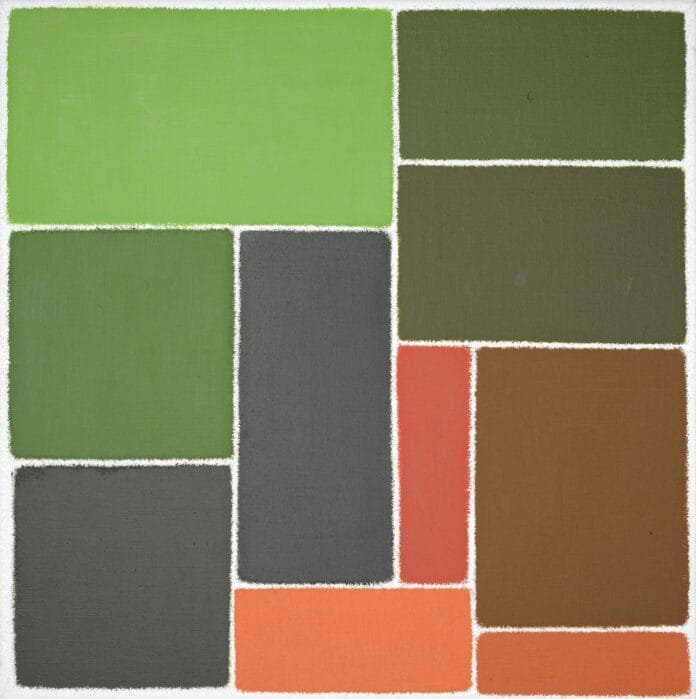Kleopatra Moursela is a contemporary Greek artist whose work bridges the realms of abstraction, memory, and spirituality. Based in Athens, she is also an Assistant Professor at the Athens School of Fine Arts, where she shares her expertise and passion with the next generation of artists. With a rich background in Interior Design, Stage Design, and Graphic Arts, alongside a Master’s Degree in Visual Arts, Moursela has cultivated a multifaceted practice that blends technical precision with profound philosophical inquiry. Her art is a journey beyond representation, a meditation on time, space, and the essence of memory.
The Artistic Vision
At the heart of Kleopatra Moursela’s practice lies a deep fascination with Abstraction, particularly Geometric Abstraction. Her paintings are not mere arrangements of shapes and colors but carefully constructed landscapes infused with spiritual resonance. In her own words, she seeks to create “landscapes in the sense of Being,” where vibrant compositions of geometric structures transcend the boundaries of the tangible world.
Her works serve as vessels that hold fragments of memory, personal and collective, and transform them into chromatic and geometric expressions. Each canvas becomes a site where past and present converge, a liminal space where recollections take form through structured lines, rhythmic grids, and luminous hues.
Geometry as Language
Moursela’s use of geometry is not purely aesthetic but philosophical. Grids, lines, and geometric forms act as her visual language for articulating existence. They are symbols of both order and disruption, harmony and conflict. In her compositions, geometric elements may harmonize seamlessly or collide dramatically, echoing the complexities of human experience.
Through this language, Moursela explores the interplay between stability and transformation. The structured elements anchor the composition, while color imbues them with vitality, emotion, and depth. The result is a dialogue between precision and spontaneity, reason and intuition.
Memory, Space, and Time
A recurring theme in Moursela’s work is the convergence of memory, space, and time. Her abstract landscapes are not depictions of physical places but rather metaphysical spaces—constructed realms where moments, histories, and emotions intertwine. In this sense, her art becomes a meditation on the nature of memory itself: fluid, layered, and transformative.
By embodying memory within color and shape, Moursela transforms the intangible into something that can be experienced visually and emotionally. These painted landscapes are not static but alive with energy, offering viewers a spiritual encounter with time’s passage and memory’s persistence.
The Spiritual Dimension
While deeply rooted in the traditions of abstraction, Moursela’s art transcends purely formal concerns. Her paintings are imbued with spiritual essence, seeking to move beyond conventional representation toward something more universal. She views space not as a backdrop but as a transformative entity, capable of expanding and dissolving boundaries.
Every brushstroke and compositional decision becomes an intentional act, a step toward constructing immersive experiences that defy earthly limitations. In this way, Moursela’s work aligns with the legacy of abstract artists who sought to evoke the unseen, Kandinsky’s spiritual abstraction, Mondrian’s quest for harmony, and the transcendental qualities of early European abstraction.
Influences and Inspirations
Moursela’s artistic sensibility is shaped by a wide range of influences. From the precision of Geometric Abstraction to the depth of Modernism, her practice resonates with both historical and contemporary dialogues. Early Renaissance painting, with its explorations of space, perspective, and symbolism, also informs her approach, offering a foundation upon which she builds her own vision.
Her fascination with early European abstraction provides continuity with the pioneers of the movement, while her engagement with modern practices ensures that her work remains fresh, innovative, and relevant. This duality, deep respect for tradition paired with an ongoing pursuit of innovation, defines her unique artistic voice.
A Living Dialogue with Abstraction
For Kleopatra Moursela, abstraction is not a closed chapter of art history but an evolving dialogue. Her commitment to pushing the boundaries of her own practice is also a contribution to the broader legacy of abstract art. She seeks to add her voice to a conversation that spans generations, cultures, and artistic movements.
Her ongoing research and exploration ensure that her practice is never static. Each new work is both a continuation and a departure, rooted in her established visual language yet open to new possibilities. In this way, Moursela affirms that abstraction remains a powerful mode of expression for the contemporary era.
Exhibitions and Recognition
Moursela’s paintings and drawings have been exhibited in galleries and cultural spaces, gaining recognition for their unique synthesis of geometry, memory, and spirituality. Audiences are drawn to the way her works invite introspection, offering not only visual pleasure but also philosophical reflection. Her ability to create immersive experiences ensures that her art resonates beyond the surface, lingering in the viewer’s imagination.
Conclusion
Kleopatra Moursela’s art embodies a profound exploration of abstraction as both form and philosophy. Through geometric structures, luminous color, and deliberate composition, she constructs landscapes of memory, time, and being. Her works are spiritual encounters with the immaterial dimensions of life, spaces where the tangible dissolves and the infinite emerges.
As both an artist and educator, Moursela continues to shape the discourse of contemporary abstraction, pushing boundaries while honoring its rich legacy. Her art is a testament to the enduring power of geometric abstraction, not as a relic of the past, but as a vibrant, living language capable of expressing the deepest dimensions of human experience.


